Keivan Rezaei
Model State Arithmetic for Machine Unlearning
Jun 26, 2025Abstract:Large language models are trained on massive corpora of web data, which may include private data, copyrighted material, factually inaccurate data, or data that degrades model performance. Eliminating the influence of such problematic datapoints through complete retraining -- by repeatedly pretraining the model on datasets that exclude these specific instances -- is computationally prohibitive. For this reason, unlearning algorithms have emerged that aim to eliminate the influence of particular datapoints, while otherwise preserving the model -- at a low computational cost. However, precisely estimating and undoing the influence of individual datapoints has proved to be challenging. In this work, we propose a new algorithm, MSA, for estimating and undoing the influence of datapoints -- by leveraging model checkpoints i.e. artifacts capturing model states at different stages of pretraining. Our experimental results demonstrate that MSA consistently outperforms existing machine unlearning algorithms across multiple benchmarks, models, and evaluation metrics, suggesting that MSA could be an effective approach towards more flexible large language models that are capable of data erasure.
Localizing Knowledge in Diffusion Transformers
May 24, 2025Abstract:Understanding how knowledge is distributed across the layers of generative models is crucial for improving interpretability, controllability, and adaptation. While prior work has explored knowledge localization in UNet-based architectures, Diffusion Transformer (DiT)-based models remain underexplored in this context. In this paper, we propose a model- and knowledge-agnostic method to localize where specific types of knowledge are encoded within the DiT blocks. We evaluate our method on state-of-the-art DiT-based models, including PixArt-alpha, FLUX, and SANA, across six diverse knowledge categories. We show that the identified blocks are both interpretable and causally linked to the expression of knowledge in generated outputs. Building on these insights, we apply our localization framework to two key applications: model personalization and knowledge unlearning. In both settings, our localized fine-tuning approach enables efficient and targeted updates, reducing computational cost, improving task-specific performance, and better preserving general model behavior with minimal interference to unrelated or surrounding content. Overall, our findings offer new insights into the internal structure of DiTs and introduce a practical pathway for more interpretable, efficient, and controllable model editing.
RePanda: Pandas-powered Tabular Verification and Reasoning
Mar 14, 2025Abstract:Fact-checking tabular data is essential for ensuring the accuracy of structured information. However, existing methods often rely on black-box models with opaque reasoning. We introduce RePanda, a structured fact verification approach that translates claims into executable pandas queries, enabling interpretable and verifiable reasoning. To train RePanda, we construct PanTabFact, a structured dataset derived from the TabFact train set, where claims are paired with executable queries generated using DeepSeek-Chat and refined through automated error correction. Fine-tuning DeepSeek-coder-7B-instruct-v1.5 on PanTabFact, RePanda achieves 84.09% accuracy on the TabFact test set. To evaluate Out-of-Distribution (OOD) generalization, we interpret question-answer pairs from WikiTableQuestions as factual claims and refer to this dataset as WikiFact. Without additional fine-tuning, RePanda achieves 84.72% accuracy on WikiFact, significantly outperforming all other baselines and demonstrating strong OOD robustness. Notably, these results closely match the zero-shot performance of DeepSeek-Chat (671B), indicating that our fine-tuning approach effectively distills structured reasoning from a much larger model into a compact, locally executable 7B model. Beyond fact verification, RePanda extends to tabular question answering by generating executable queries that retrieve precise answers. To support this, we introduce PanWiki, a dataset mapping WikiTableQuestions to pandas queries. Fine-tuning on PanWiki, RePanda achieves 75.1% accuracy in direct answer retrieval. These results highlight the effectiveness of structured execution-based reasoning for tabular verification and question answering. We have publicly released the dataset on Hugging Face at datasets/AtoosaChegini/PanTabFact.
A Survey on Mechanistic Interpretability for Multi-Modal Foundation Models
Feb 22, 2025



Abstract:The rise of foundation models has transformed machine learning research, prompting efforts to uncover their inner workings and develop more efficient and reliable applications for better control. While significant progress has been made in interpreting Large Language Models (LLMs), multimodal foundation models (MMFMs) - such as contrastive vision-language models, generative vision-language models, and text-to-image models - pose unique interpretability challenges beyond unimodal frameworks. Despite initial studies, a substantial gap remains between the interpretability of LLMs and MMFMs. This survey explores two key aspects: (1) the adaptation of LLM interpretability methods to multimodal models and (2) understanding the mechanistic differences between unimodal language models and crossmodal systems. By systematically reviewing current MMFM analysis techniques, we propose a structured taxonomy of interpretability methods, compare insights across unimodal and multimodal architectures, and highlight critical research gaps.
RESTOR: Knowledge Recovery through Machine Unlearning
Oct 31, 2024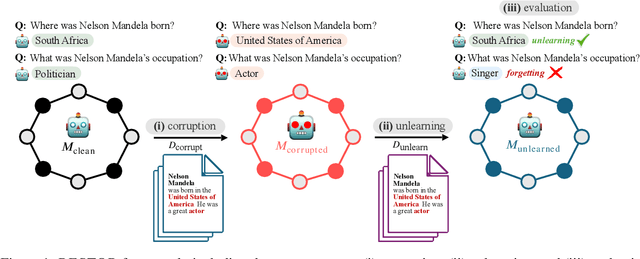
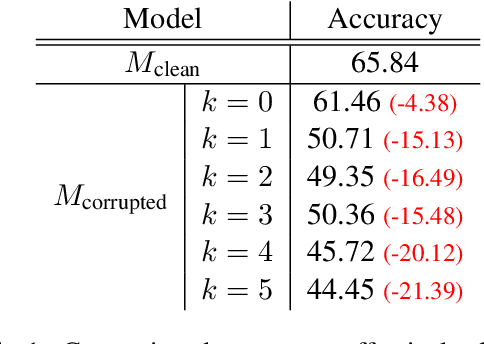
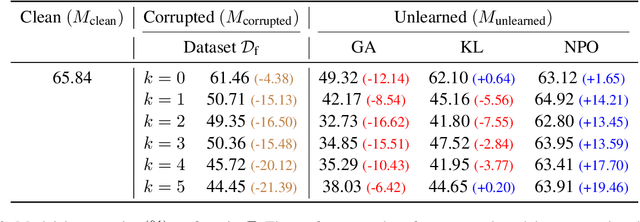
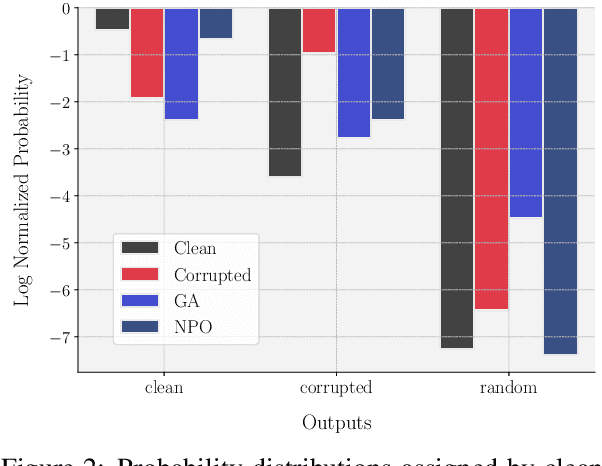
Abstract:Large language models trained on web-scale corpora can memorize undesirable datapoints such as incorrect facts, copyrighted content or sensitive data. Recently, many machine unlearning methods have been proposed that aim to 'erase' these datapoints from trained models -- that is, revert model behavior to be similar to a model that had never been trained on these datapoints. However, evaluating the success of unlearning algorithms remains challenging. In this work, we propose the RESTOR framework for machine unlearning based on the following dimensions: (1) a task setting that focuses on real-world factual knowledge, (2) a variety of corruption scenarios that emulate different kinds of datapoints that might need to be unlearned, and (3) evaluation metrics that emphasize not just forgetting undesirable knowledge, but also recovering the model's original state before encountering these datapoints, or restorative unlearning. RESTOR helps uncover several novel insights about popular unlearning algorithms, and the mechanisms through which they operate -- for instance, identifying that some algorithms merely emphasize forgetting the knowledge to be unlearned, and that localizing unlearning targets can enhance unlearning performance. Code/data is available at github.com/k1rezaei/restor.
Understanding and Mitigating Compositional Issues in Text-to-Image Generative Models
Jun 12, 2024



Abstract:Recent text-to-image diffusion-based generative models have the stunning ability to generate highly detailed and photo-realistic images and achieve state-of-the-art low FID scores on challenging image generation benchmarks. However, one of the primary failure modes of these text-to-image generative models is in composing attributes, objects, and their associated relationships accurately into an image. In our paper, we investigate this compositionality-based failure mode and highlight that imperfect text conditioning with CLIP text-encoder is one of the primary reasons behind the inability of these models to generate high-fidelity compositional scenes. In particular, we show that (i) there exists an optimal text-embedding space that can generate highly coherent compositional scenes which shows that the output space of the CLIP text-encoder is sub-optimal, and (ii) we observe that the final token embeddings in CLIP are erroneous as they often include attention contributions from unrelated tokens in compositional prompts. Our main finding shows that the best compositional improvements can be achieved (without harming the model's FID scores) by fine-tuning {\it only} a simple linear projection on CLIP's representation space in Stable-Diffusion variants using a small set of compositional image-text pairs. This result demonstrates that the sub-optimality of the CLIP's output space is a major error source. We also show that re-weighting the erroneous attention contributions in CLIP can also lead to improved compositional performances, however these improvements are often less significant than those achieved by solely learning a linear projection head, highlighting erroneous attentions to be only a minor error source.
Ad Auctions for LLMs via Retrieval Augmented Generation
Jun 12, 2024Abstract:In the field of computational advertising, the integration of ads into the outputs of large language models (LLMs) presents an opportunity to support these services without compromising content integrity. This paper introduces novel auction mechanisms for ad allocation and pricing within the textual outputs of LLMs, leveraging retrieval-augmented generation (RAG). We propose a segment auction where an ad is probabilistically retrieved for each discourse segment (paragraph, section, or entire output) according to its bid and relevance, following the RAG framework, and priced according to competing bids. We show that our auction maximizes logarithmic social welfare, a new notion of welfare that balances allocation efficiency and fairness, and we characterize the associated incentive-compatible pricing rule. These results are extended to multi-ad allocation per segment. An empirical evaluation validates the feasibility and effectiveness of our approach over several ad auction scenarios, and exhibits inherent tradeoffs in metrics as we allow the LLM more flexibility to allocate ads.
On Mechanistic Knowledge Localization in Text-to-Image Generative Models
May 02, 2024

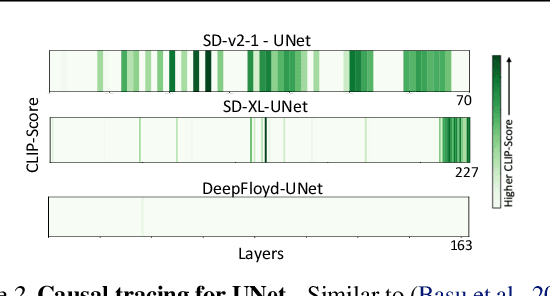
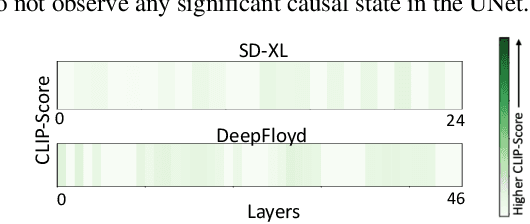
Abstract:Identifying layers within text-to-image models which control visual attributes can facilitate efficient model editing through closed-form updates. Recent work, leveraging causal tracing show that early Stable-Diffusion variants confine knowledge primarily to the first layer of the CLIP text-encoder, while it diffuses throughout the UNet.Extending this framework, we observe that for recent models (e.g., SD-XL, DeepFloyd), causal tracing fails in pinpointing localized knowledge, highlighting challenges in model editing. To address this issue, we introduce the concept of Mechanistic Localization in text-to-image models, where knowledge about various visual attributes (e.g., ``style", ``objects", ``facts") can be mechanistically localized to a small fraction of layers in the UNet, thus facilitating efficient model editing. We localize knowledge using our method LocoGen which measures the direct effect of intermediate layers to output generation by performing interventions in the cross-attention layers of the UNet. We then employ LocoEdit, a fast closed-form editing method across popular open-source text-to-image models (including the latest SD-XL)and explore the possibilities of neuron-level model editing. Using Mechanistic Localization, our work offers a better view of successes and failures in localization-based text-to-image model editing. Code will be available at \href{https://github.com/samyadeepbasu/LocoGen}{https://github.com/samyadeepbasu/LocoGen}.
Online Advertisements with LLMs: Opportunities and Challenges
Nov 11, 2023Abstract:This paper explores the potential for leveraging Large Language Models (LLM) in the realm of online advertising systems. We delve into essential requirements including privacy, latency, reliability, users and advertisers' satisfaction, which such a system must fulfill. We further introduce a general framework for LLM advertisement, consisting of modification, bidding, prediction, and auction modules. Different design considerations for each module is presented, with an in-depth examination of their practicality and the technical challenges inherent to their implementation.
Regret Analysis of Repeated Delegated Choice
Oct 10, 2023Abstract:We present a study on a repeated delegated choice problem, which is the first to consider an online learning variant of Kleinberg and Kleinberg, EC'18. In this model, a principal interacts repeatedly with an agent who possesses an exogenous set of solutions to search for efficient ones. Each solution can yield varying utility for both the principal and the agent, and the agent may propose a solution to maximize its own utility in a selfish manner. To mitigate this behavior, the principal announces an eligible set which screens out a certain set of solutions. The principal, however, does not have any information on the distribution of solutions in advance. Therefore, the principal dynamically announces various eligible sets to efficiently learn the distribution. The principal's objective is to minimize cumulative regret compared to the optimal eligible set in hindsight. We explore two dimensions of the problem setup, whether the agent behaves myopically or strategizes across the rounds, and whether the solutions yield deterministic or stochastic utility. Our analysis mainly characterizes some regimes under which the principal can recover the sublinear regret, thereby shedding light on the rise and fall of the repeated delegation procedure in various regimes.
 Add to Chrome
Add to Chrome Add to Firefox
Add to Firefox Add to Edge
Add to Edge